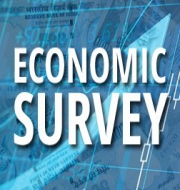Highlights of Economic Survey 2016-17
Union finance Minister Arun Jaitley tabled the Economic Survey 2016-17 in Parliament budget session. The survey prepared by chief economic adviser in the finance ministry Arvind Subramanian.
The survey projects the economy to grow in the range of 6.75% to 7.25% in fiscal year 2017-18 in the post-demonetisation year. It says that the adverse impact of demonetisation on GDP growth will be transitional.
Major highlights from the Economic Survey 2016-17
- Growth Forecast: Gross domestic product (GDP) growth in 2016-17 pegged at 6.5%, down from 7.6% in last fiscal 2015-16.
- Economic growth to rebound to 6.75 to 7.5% in 2017-18.
- Farm sector to grow at 4.1% in 2016-17, up from 1.2% in 2015-16.
- Growth rate of industrial sector estimated to moderate to 5.2% in 2016-17 from 7.4% in 2015-16.
- Service sector is estimated to grow at 8.9% in 2016-17
- GST, other structural reforms should take the growth rate trend to 8-10%.
- Taxation: Prescribes cut in individual Income Tax rates, real estate stamp duties.
- IT net could be widened gradually by encompassing all high income earners.
- Time table for cutting corporate tax should be accelerated.
- Tax administration could be improved to reduce discretion and improve accountability.
- Goods and Services Tax (GST): Fiscal gains from GST will take time to realise.
- Fiscal Deficit: Implementation of muted tax receipts, wage hike to put pressure on fiscal deficit in 2017-18.
- For fiscal health of the economy fiscal prudence for both centre and states is needed.
- Fiscal windfall from low oil prices to disappear in 2017-18.
- Inflation: The average consumer price index (CPI) inflation rate declined to 4.9% in 2015-16 from 5.9% in 2014-15. CPI-based core inflation remained sticky around 5% in the 2016-17.
- Oil prices, seen rising by one-sixth in 2017-18 over the previous fiscal 2016-17 prices which could dampen India’s economic growth.
- Monetary Policy: monetary easing headroom may be capped due to sharp rise in prices in 2017-18.
- Market interest rates seen lower in 2017-18 due to demonetisation.
- Government Debt to GDP ratio: It was 68.5% in 2016, down from 69.1% in 2015.
- Banking: Suggests setting up public sector asset rehabilitation agency (PSARA) to take charge of large bad loans in banks. With government backing, PSAR can overcome coordination and political issues on bad loans.
- Demonetisation: The adverse impact of demonetisation on GDP growth will be transitional. It will affect growth rate by 0.25-0.5%, but to have long-term benefits
- It may affect supplies of certain agricultural products like sugar, milk, potatoes and onions.
- Remonetisation will ensure that the cash squeeze is eliminated by April 2017.
- Universal Basic Income (UBI): Advocates the concept of UBI as an alternative to the various social welfare schemes in an effort to reduce poverty.
- It will be alternative to plethora of state subsidies for poverty alleviation. UBI would cost between 4 and 5% of GDP
Month: Current Affairs - January, 2017



karthik
January 31, 2017 at 8:49 pmthat’s good
karthik
January 31, 2017 at 8:49 pmthat’s good
MAHESH KADAM
February 1, 2017 at 4:56 pmVALUABLE AND WORTHY
MAHESH KADAM
February 1, 2017 at 4:56 pmVALUABLE AND WORTHY
Gyaaneshwar Joshi
February 1, 2017 at 10:24 pmVery important for exam point of view.
Gyaaneshwar Joshi
February 1, 2017 at 10:24 pmVery important for exam point of view.
Amatullah
February 14, 2017 at 6:57 amThanks for the current affairs
Amatullah
February 14, 2017 at 6:57 amThanks for the current affairs
Mohd imtinan gaur
May 13, 2017 at 11:48 amVery important for the exam point
Thanx
Mohd imtinan gaur
May 13, 2017 at 11:48 amVery important for the exam point
Thanx